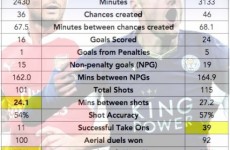*
Is the Board of Control for Cricket in India really a bastion of trenchant conservatism? Judging by its steadfast refusal to adopt the Umpire Decision Review System (DRS), the answer would seem to be yes; then again, it has been in the vanguard in embracing the all-singing, all-dancing, Brave New World of Twenty20, with the latest season of its brashest incarnation, the IPL, imminent. In his debut article for Sportingintelligence, Scott Oliver asks: ‘BCCI: Revolutionary or reactionary? And wouldn’t DRS actually benefit Indian cricket?’
.
.
19 March 2012
There is still widespread bewilderment that the BCCI have been so obstinately anti-modern in their stance on DRS, particularly when its introduction was provoked, in large part, by umpiring mistakes in the infamous and contentious Sydney Test of 2008 that cost India so dearly.
It is more perplexing given that neither of the two most obvious reasons stand up to scrutiny.
Firstly, their misgivings about the accuracy of ball-tracking technology (Hawk-Eye or Virtual Eye alike) are either a smokescreen concealing a powerful lobby within the team, or, more likely, a sincerely held yet barely plausible stance.
As with evolution, DRS, at present, need not be ‘perfect’: a fittest design. It is only a resource.
Basing your opposition to DRS on the fact that it isn’t foolproof is akin to sticking to a homeopathic potion because the $10 billion medical facility up the road doesn’t cure 100 per cent of patients.
Despite the alarmists’ caricature the umpires are not obliged to devolve agency to the technology wholesale.
In cases in which the video evidence is drastically contradicted by the virtual reconstruction of Hawk-Eye, generally off the bowling of spinners when there is little distance between ball pitching and striking the pad – as happened with Phillip Hughes in Sri Lanka last August – surely they can, as arbiters, choose to rely on a combination of their eyesight and the camera.
And if Hawk-Eye does have a blind spot, then at the very least a TV replay helps umpires decide where the ball pitched: not perfect; an improvement. And let’s not forget that, in the context of cricket officiating, the human eye is but an imperfect ball-tracking device.
Secondly, absolutist belief that the umpire’s verdict is final is symptomatic of what might be termed a ‘theological attitude’.
Around the time of the launch of DRS in 2009, Ian Chappell wrote that the unquestioned acceptance of the umpire’s decision was the foundation of the game. (Certainly, his compatriot, Simon Taufel, a five-time winner of the ICC’s Umpire of the Year award, is cutting an increasingly crestfallen figure as more of his decisions are overturned).
But surely the point is the one lucidly made by the late Peter Roebuck, that “nothing is more calculated to reduce authority than allowing obviously erroneous judgement to stand”.
Ultimately, Chappell’s is an absurd stance, tantamount to saying he would rather have ‘honest mistakes’ than greater justice. Truly, it belongs in Lewis Carroll.
What sort of judicial system deprives its accused of the right of appeal if there is further evidence to be considered? Well, one that confines authority to the will of an individual, like the absolutist monarchies or totalitarian dictatorships.
One obvious compromise, at least on the face of things, would be to allow the umpires themselves to refer any decision they wish upstairs, which shows that authority per se is not being undermined, only that the means for arriving at decisions is being broadened.
However, the likely consequences would be that umpires would tend – much as happens with line decisions – to refer all decisions in which there was even a scintilla of doubt (which, given the fallibility of humans’ perceptual apparatus, would be many).
.
 LEAVING aside whether or not the Indian reservations are legitimate, here’s the thing that no one seems to have recognised: DRS could be precisely the mechanism that revives India’s fortunes in the Test arena.
LEAVING aside whether or not the Indian reservations are legitimate, here’s the thing that no one seems to have recognised: DRS could be precisely the mechanism that revives India’s fortunes in the Test arena.
Think about it.
The single biggest change it has brought about is the number of lbw decisions going to spinners. The increase was evident before DRS was formally introduced, prompted by umpires watching Hawkeye footage and seeing how many previously rejected front-foot lbw appeals were actually going on to hit the stumps. The technology led to a shift in perception.
Reciprocally, this tendency to uphold more appeals is already affecting batsmen, bringing about modifications in previously well-honed and well-adapted techniques, not to mention in tactics and perhaps even selection.
One such batsman, Kevin Pietersen, even ascribes this qualitative change to a precise moment: when, on debut in Nagpur in 2006, Monty Panesar snared Sachin Tendulkar lbw on the front foot.
At any rate, in the recently concluded series between Pakistan and England, 43 out of 110 wickets fell to lbws, 32 of those to spinners (in part attributable to the characteristics of the pitches).
And India is of course the land of producing spinners.
Anil Kumble’s 619 wickets and Harbajhan’s 406 are not negligible hauls, although one wonders how many more victims the former, particularly, would have snared under DRS.
And the national side are very rarely without top-class twirlers and tweakers – one only need mention the great quartet from the 1970s: Erapalli Prasanna, Bishan Bedi, Bhagwath Chandrasekhar and Srinivas Venkataraghavan.
It should be borne in mind that it is not a simple case of bowling straight at 60mph, of course, and that you still need to deceive the batsman in flight and off the pitch, but it would seem that India is a country well equipped to prosper from DRS.
Not only is India the fecund soil from which sprout many a spinner, it is also the land in which batsmen grow up most adept at playing spin – with the bat, not the pad.
And therein lies the point that the BCCI seem not to have fully grasped: there is no need for any high-mindedness or some noble gesture ‘for the good of the game’ for India to U-turn and adopt the DRS.
It can be done on the entirely pragmatic grounds of it increasing their potency and gaining an advantage.
.
Scott Oliver blogs on cricket at The Reverse Sweeper (where you’ll find a longer version of this piece, drawing on evolutionary theory); he blogs on football at False9; and, in the latest issue of The Blizzard, tells the story of the curious short-term rivalry that took hold between Athletic Bilbao and Barcelona at the start of the 1980s. You can also follow him on Twitter.
.
Follow SPORTINGINTELLIGENCE on Twitter
Sportingintelligence home page










